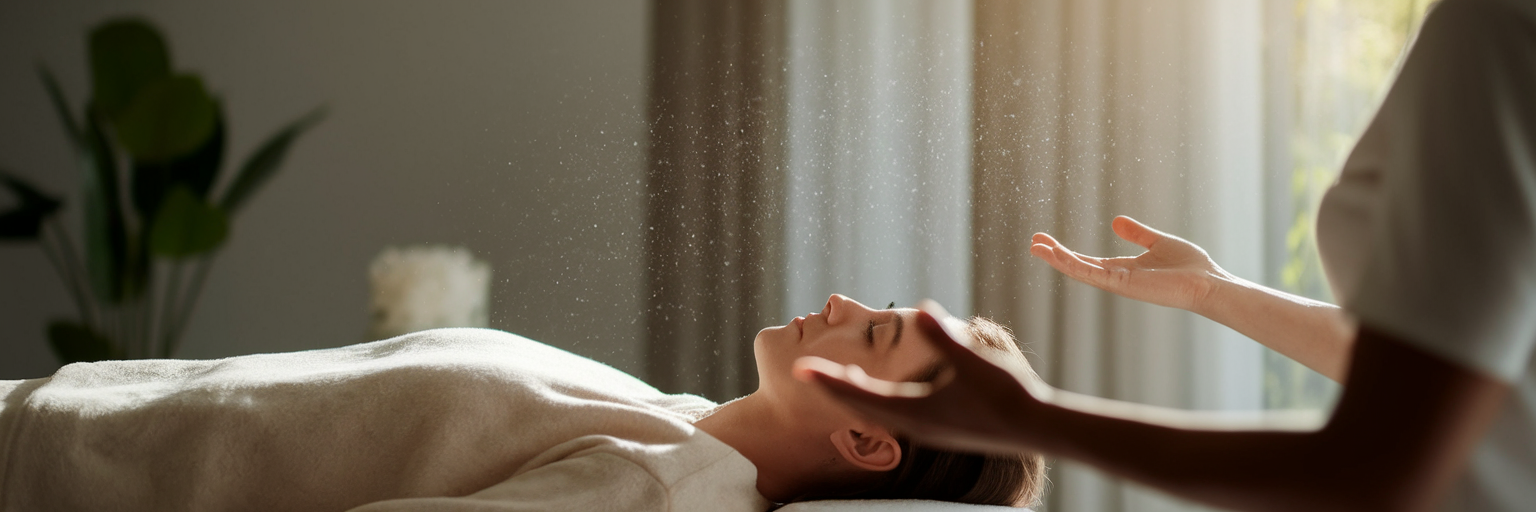
Finding Your Inner Balance with Reiki Healing
The Gentle Art of Energy Healing
Does your personal battery ever feel like it’s stuck at one percent? In a world that constantly asks for our attention, it’s easy to feel drained, scattered, and a little disconnected from ourselves. We try to recharge with coffee or a weekend binge watch, but sometimes what we really need is a gentler, more profound kind of reset. This is where Reiki comes in, not with a jolt, but with a quiet, soothing hum.
So, what is reiki healing? At its heart, Reiki is a Japanese technique for relaxation that also promotes healing. It’s based on the principle that a practitioner can channel energy into the patient by means of touch, to activate the natural healing processes of the patient's body and restore physical and emotional well-being. Think of this "universal life force energy" not as something mystical, but as the same quiet vitality you feel from the warmth of the sun on your skin or the peaceful stillness of a forest. It’s a natural, life-supporting energy that flows through all living things.
Founded by Mikao Usui in the early 20th century, Reiki is a spiritual practice, but it is not a religion. It requires no specific belief system, only a willingness to be open and relax. It’s about tapping into a natural source of vitality to feel more like yourself, a core principle we explore throughout our work at Feed Your Spirit. It’s a simple, time-honored way to find your center again.
What Happens During a Reiki Session
Walking into your first Reiki session can feel a bit mysterious, but the reality is wonderfully simple and comforting. Imagine a calm, quiet room with soft lighting, where you get to lie down fully clothed on a comfortable massage table, wrapped in a cozy blanket. Your only job is to breathe and relax. No pressure, no expectations.
The practitioner’s role is not to be a magical healer with special powers, but rather a conduit for energy. Think of them as a garden hose, simply directing the flow of water where it’s needed most. They don’t use their own energy; they channel the universal life force to support your body’s own incredible intelligence to heal itself. They will gently place their hands in a series of positions, either with a very light touch or hovering just above your body. You might notice their hands linger over certain spots for a little longer. These hand placements often correspond to the body's seven main energy centers, also known as the chakras.
What will you feel? The experience is unique to everyone. Some people feel a gentle warmth or a pleasant tingling sensation spreading through their body. Others see soft colors behind their closed eyelids or feel a sense of floating. And many people feel nothing more than a profound state of deep relaxation, as if they’ve just had the best nap of their life. All of these experiences are perfectly normal and equally beneficial. The goal isn’t a dramatic event, but a gentle, respectful, and peaceful state of rest.
Benefits for a Less Stressed Mind
One of the most immediate and noticeable reiki energy healing benefits is the deep sense of calm it brings. It’s a powerful antidote to a mind that feels like it has too many tabs open. Reiki helps your nervous system shift from its frantic "fight-or-flight" mode into a peaceful "rest-and-digest" state. It’s like someone gently turning down the volume on all that internal chatter, leaving you with a quiet mind.
This deep relaxation creates the perfect conditions for both mental and emotional release. Here are a few ways it can help:
- Stress and Anxiety Reduction: By calming the nervous system, Reiki provides a space for your body and mind to let go of accumulated tension. As noted by Cleveland Clinic, potential health benefits of Reiki include reduced anxiety and a boosted mood.
- Gentle Emotional Release: Reiki is one of the most gentle emotional healing techniques. It can feel like a quiet emotional decluttering, allowing suppressed feelings to surface and release without the need to analyze or even talk about them.
- Improved Sleep: When your mind is quieter and your body is relaxed, better sleep often follows. Many people report deeper, more restorative sleep after a session.
- Relief from Physical Tension: That persistent tightness in your shoulders or the tension headache that won’t quit? They are often physical manifestations of stress. Reiki for stress relief helps the body release these patterns.
This deep state of rest is similar to what can be achieved through dedicated meditation practices. Reiki doesn’t "fix" you because you are not broken. It simply creates a supportive environment for your own innate wisdom to restore balance.
Connecting to Your Deeper Self
While the stress-busting benefits are wonderful, Reiki also offers a path to something deeper: a stronger connection to yourself. This isn't about achieving some lofty spiritual goal. It’s about the simple, grounded act of becoming more self-aware and finally being able to hear your own intuition over the noise of daily life.
By helping to clear away energetic clutter, Reiki can create a feeling of being truly centered and present in your own body. It’s that feeling of "coming home to yourself." For some, this newfound clarity can lead to a sudden burst of creativity, a solution to a problem they’ve been mulling over, or a clear sense of direction on a big life decision. This newfound clarity can sometimes feel like you're aligning more closely with your true intentions, a key idea in manifestation work.
It’s important to remember that this experience is highly personal. For one person, a session might bring profound personal insights and a feeling of connection to everything. For another, it might simply be an hour of uninterrupted peace that leaves them feeling refreshed and grounded. Both outcomes are equally valid and beautiful. There’s no right or wrong way to experience it. The journey is yours alone.
How to Begin Your Reiki Journey
Feeling ready to give it a try? There are two wonderful ways to bring Reiki into your life: finding a practitioner to work with or learning to practice it yourself. Both paths offer their own unique rewards.
Finding a Qualified Practitioner
Knowing how to find a reiki practitioner you connect with is the most important first step. Look for someone who is certified to at least Reiki Level 2 (the practitioner level) and whose energy feels right to you. Don't be shy about asking a few questions before you book:
- Where did you receive your training and what is your lineage?
- How would you describe your approach to a session?
- What can I expect during and after our time together?
- How long have you been practicing professionally?
Ultimately, trust your gut. The best practitioner for you is someone with whom you feel safe, comfortable, and respected.
Learning Reiki for Yourself
Perhaps the most empowering step is to learn reiki for beginners. Anyone can learn to channel this energy for their own self-care and to share with friends, family, and even pets. The training is typically broken down into three levels.
| Reiki Level | Primary Focus | What You Can Do |
|---|---|---|
| Level 1 (Shoden) | Self-Healing & Awareness | Practice on yourself, friends, family, and pets. |
| Level 2 (Okuden) | Practitioner Level | Practice professionally on others and learn distance healing. |
| Level 3 (Shinpiden) / Master | Teaching & Deeper Commitment | Teach Reiki to others and attune new students. |
Note: The names and structure of levels can vary slightly between different Reiki lineages, but this three-level system is the most common framework in the West.
As you learn to work with your own energy in Level 1, you may find it helpful to deepen your understanding of the body's energy centers through a chakra meditation course. Find a Reiki Master-Teacher whose style resonates with you, and enjoy the beautiful journey of self-discovery.




